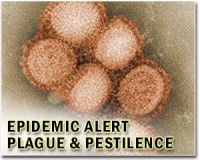| . |  |
. |
Washington (AFP) Nov 4, 2009 Swine flu infections in the United States will be past their peak when (A)H1N1 vaccine becomes readily available, a top health official said Wednesday. "It is likely that the current wave of infection will peak, crest and begin to decline before there are ample supplies," Thomas Frieden, director of the Center for Disease Control and Prevention (CDC) told lawmakers at a briefing. "Currently we are continuing to see virus activity and the number of people getting sick increase in many states, although it has already begun to decrease in other states, particularly in the southeast," Frieden said. "Whether there will be another wave of H1N1 between now and May when the flu season ends or whether we'll get another strain of influenza, only time will tell," he told the briefing called to address a serious shortage of vaccine in the United States. Nicole Kunka, a staff member of the House Appropriations Subcommittee on Labor, Health and Human Services, said the government had fallen "miserably short" of its H1N1 vaccine production goal. "Initial government estimates were that 160 million doses would be available by October... on October 29, 24.8 million doses were available," she said. Kunka cited statistics from the Department of Health and Human Services which "indicate that doses sufficient to cover all priority populations will likely not be available before January 2010." The vaccine shortfall has seen long lines forming outside health clinics, with many people in the five priority groups for inoculation being turned away or going home without getting their swine flu shot as vaccine supplies ran dry. Children and pregnant women have been particularly hard hit by the swine flu pandemic. Other priority groups include health care workers, people with chronic health conditions such as asthma, and childcare workers who cannot themselves be vaccinated. More than 5,700 people have died worldwide since the virus was first discovered in April, with most of the deaths -- 4,175 -- in the Americas region, the World Health Organization said Friday.
earlier related report "Despite having lower hospitalization rates, persons aged 50 years or older who were hospitalized with pandemic 2009 influenza (A)H1N1 infection were among those most likely to die," a study conducted by researchers at the California department of health showed. Around 11 percent of the 1,088 cases of swine flu reported in California between April 17 and August 22 died, the study showed. The death rate for people 50 and older was around 19 percent, compared to seven percent for children under 18, who made up around a third of swine flu cases reported in California. Nearly 12 infants out of 100,000 had to be hospitalized for swine flu in the first four months of the outbreak in California, giving the tiny tots the highest hospitalization rate of any age group. "The youngest age group, infants aged two months or younger, had the highest hospitalization rates but are too young to receive currently licensed influenza vaccines," the study said. The findings support recommendations for caregivers of the very young to be given priority for swine flu vaccination, it added. US health officials have repeatedly characterized swine flu as "a younger person's disease," and put children and young adults under the age of 25 on a list of five priority groups for vaccination against the disease. The others are health care workers, infant caregivers, pregnant women and adults up to age 65 with certain underlying health conditions. The California researchers said the median age for hospitalized and fatal swine flu cases was 27 years -- younger than is commonly seen with seasonal flu. "For seasonal influenza, persons older than 64 years, younger than five years, or who have specific medical conditions have higher rates of hospitalization and death," the study said. Even though swine flu is perceived as causing "only mild disease," the researchers also found that about a third of hospitalized cases were severely ill and required intensive care. Twenty percent of pregnant women in the study spent time in the intensive care unit, and most hospitalized adults, and more than one-third of children, required mechanical ventilation. The most common causes of death were viral pneumonia and acute respiratory distress syndrome, the study said. The United States is battling swine flu amid shortages of vaccine, which has seen states and counties cancel inoculation clinics, and of children's anti-viral medicine, which last week saw federal authorities raiding the strategic stockpile for kids' liquid Tamiflu. Pandemic H1N1 flu has already claimed the lives of more children than seasonal flu typically does during an entire flu season, which runs from August until May. More than 5,700 people have died worldwide since the virus was first discovered in April, with most of the deaths -- 4,175 -- in the Americas region, the World Health Organization said Friday. Share This Article With Planet Earth
Related Links Epidemics on Earth - Bird Flu, HIV/AIDS, Ebola
 Death toll rises to 86 in Ukraine flu epidemic: ministry
Death toll rises to 86 in Ukraine flu epidemic: ministryKiev (AFP) Nov 4, 2009 Eighty-six people have died in Ukraine from flu and respiratory infections, the health ministry said Wednesday, in an epidemic the World Health Organisation said could be largely due to the A(H1N1) virus. The ministry said that almost half a million cases of flu and acute respiratory infections had been recorded since mid-October in the country of 46 million, while 24,000 people have been ... read more |
|
| The content herein, unless otherwise known to be public domain, are Copyright 1995-2009 - SpaceDaily. AFP and UPI Wire Stories are copyright Agence France-Presse and United Press International. ESA Portal Reports are copyright European Space Agency. All NASA sourced material is public domain. Additional copyrights may apply in whole or part to other bona fide parties. Advertising does not imply endorsement,agreement or approval of any opinions, statements or information provided by SpaceDaily on any Web page published or hosted by SpaceDaily. Privacy Statement |